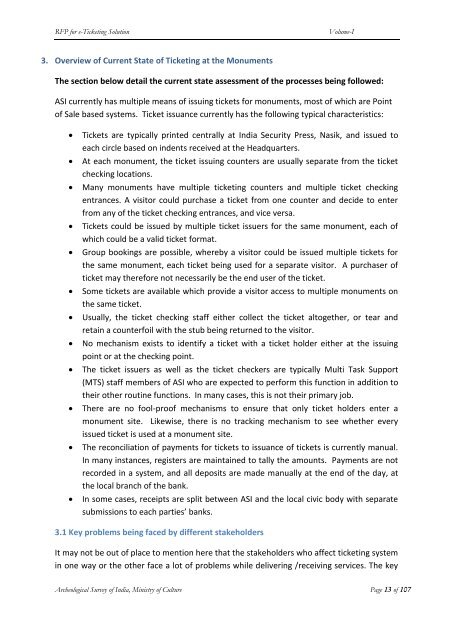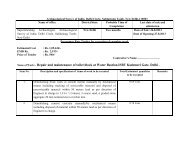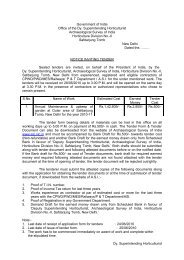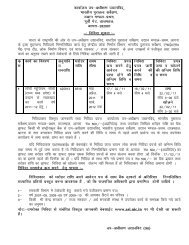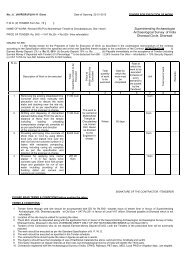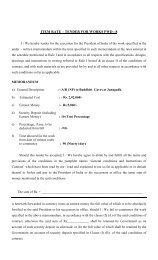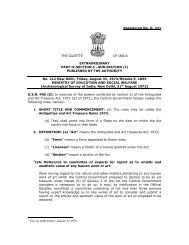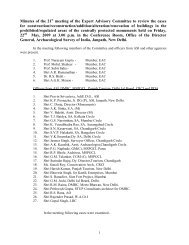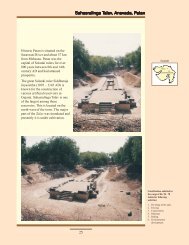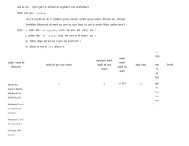Request for Proposal for e Ticketing Project - Archaeological Survey ...
Request for Proposal for e Ticketing Project - Archaeological Survey ...
Request for Proposal for e Ticketing Project - Archaeological Survey ...
You also want an ePaper? Increase the reach of your titles
YUMPU automatically turns print PDFs into web optimized ePapers that Google loves.
RFP <strong>for</strong> e-<strong>Ticketing</strong> Solution Volume-I<br />
3. Overview of Current State of <strong>Ticketing</strong> at the Monuments<br />
The section below detail the current state assessment of the processes being followed:<br />
ASI currently has multiple means of issuing tickets <strong>for</strong> monuments, most of which are Point<br />
of Sale based systems. Ticket issuance currently has the following typical characteristics:<br />
Tickets are typically printed centrally at India Security Press, Nasik, and issued to<br />
each circle based on indents received at the Headquarters.<br />
At each monument, the ticket issuing counters are usually separate from the ticket<br />
checking locations.<br />
Many monuments have multiple ticketing counters and multiple ticket checking<br />
entrances. A visitor could purchase a ticket from one counter and decide to enter<br />
from any of the ticket checking entrances, and vice versa.<br />
Tickets could be issued by multiple ticket issuers <strong>for</strong> the same monument, each of<br />
which could be a valid ticket <strong>for</strong>mat.<br />
Group bookings are possible, whereby a visitor could be issued multiple tickets <strong>for</strong><br />
the same monument, each ticket being used <strong>for</strong> a separate visitor. A purchaser of<br />
ticket may there<strong>for</strong>e not necessarily be the end user of the ticket.<br />
Some tickets are available which provide a visitor access to multiple monuments on<br />
the same ticket.<br />
Usually, the ticket checking staff either collect the ticket altogether, or tear and<br />
retain a counterfoil with the stub being returned to the visitor.<br />
No mechanism exists to identify a ticket with a ticket holder either at the issuing<br />
point or at the checking point.<br />
The ticket issuers as well as the ticket checkers are typically Multi Task Support<br />
(MTS) staff members of ASI who are expected to per<strong>for</strong>m this function in addition to<br />
their other routine functions. In many cases, this is not their primary job.<br />
There are no fool-proof mechanisms to ensure that only ticket holders enter a<br />
monument site. Likewise, there is no tracking mechanism to see whether every<br />
issued ticket is used at a monument site.<br />
The reconciliation of payments <strong>for</strong> tickets to issuance of tickets is currently manual.<br />
In many instances, registers are maintained to tally the amounts. Payments are not<br />
recorded in a system, and all deposits are made manually at the end of the day, at<br />
the local branch of the bank.<br />
In some cases, receipts are split between ASI and the local civic body with separate<br />
suissios to eah paties aks.<br />
3.1 Key problems being faced by different stakeholders<br />
It may not be out of place to mention here that the stakeholders who affect ticketing system<br />
in one way or the other face a lot of problems while delivering /receiving services. The key<br />
Archeological <strong>Survey</strong> of India, Ministry of Culture Page 13 of 107


